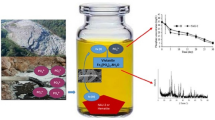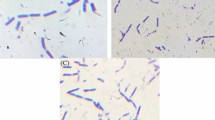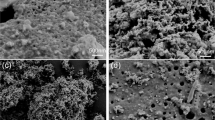Abstract
Iron particles, oxidized by Cr(VI), were not effective for additional Cr(VI) removal, but the removal rates of Cr(VI) dramatica Ily increased when iron-reducing consortium were added to the oxidized iron. The elevated removal rate was even greater than that f or iron particles. Addition of iron-reducing consortium to the oxidized iron generated ferrous ions, indicating recovery in the reactivity of iron particles as the ferrous ions could reduce additional hexavalent chromium to trivalent chromium, which is less toxic and immobile compared to hexavalent chromium. The iron-reducing consortium itself could also remove hexavalent chromium via reduction reaction as modest amount ofBacillus sp., which are known hexavalent chromium-reducing bacteria, were found. Combined effects ofbacillus sp. and ferrous ions accelerated the removal rate of Cr(VI). Waste leaves were used as alternative substrate in this research and they supported the activity of iron-reducing consortium in the presence of the oxidized iron. Al though the activity of iron-reducing consortium supported by waste leaves was lower (approximately one order of magnitude) than that supported by nutrients, the removal rate of Cr(VI) was sufficiently high indicating waste leaves could be used as a nutrient source for iron-reducing consortium.
Similar content being viewed by others
References
Blowes, D., Ptacek, C., and Jambor, J. (1997). “In-situ remediation of Cr(VI)-contaminated groundwater using permeable reactive walls: laboratory studies,”Environ. Sci. Technol., Vol. 31, No. 12, pp. 3348–3357.
Buerge, I. and Hug, S. (1997). “Kinetics and pH dependence of chromium(VI) reduction by iron(II),”Environ. Sci. Technol., Vol. 31, No. 5, pp. 1426–1432.
Fendor, S. and Li G. (1996). “Kinetics of chromate reduction by ferrous iron.”Environ. Sci. Technol., Vol. 30, No. 5, pp. 1614–1617.
Gerlach, R., Cunningham, A. and Caccavo, F. (2000). “Dissimilatory iron-reducing bacteria can influence the reduction of carbon tetrachloride by iron metal.”Environ. Sci. Technol., Vol. 34, No. 12, pp. 2461–2464.
Hofstetter, T., Heijman, C., Haderlein, S., Hollinger, C., and Schwarzenbach, R. (1999). “Complete reduction of TNT and other (poly)nitro-aromatic compounds under iron reducing subsurface condition.”Environ. Sci. Technol., Vol. 33, No. 9, pp. 1479–1487.
Lee, E., Cho, K., Ryu, H., and Chang, Y. (1999). “Microbial removal of fe(III) impurities from clay using dissimilatory iron reducers.”Journal of Bioscience and Bioengineering, Vol. 87, No. 3, pp. 397–399.
Lee, T., Lim, H., Lee, Y., and Park, J.W. (2003). “Use of waste iron metal for removal of Cr(IV) from water.”Chemosphere., Vol. 53, No. 5, pp. 479–385.
Lovley, D. and Phillips, E. (1986). “Availability of ferric iron for microbial reduction in bottom sediments of the freshwater tidal Potamac River.”Applied Environmental Microbiology., Vol. 51, No. 4, pp. 683–689.
Lovley, D. and Phillips, E. (1988). “Novel mode of microbial energy metabolism: organic carbon oxidation coupled to dissimilatory reduction of iron mangane.”Applied Environmental Microbiology. Vol. 54, No. 5, pp. 1472–1480.
Mccormick, M., Bouwer, E., and Adriaens, P. (2002). “Carbon tetrachloride transformation in a model iron-reducing culture: relative kinetics of biotic and abiotic reactions.”Environ. Sci. Technol., Vol. 36, No. 3, pp. 403–410.
Nevin, K. and Lovely, D. (2000). “Lack of production of electorn-shuttling compounds or solubilization of Fe(III) during reduction of insoluble Fe(III) oxide by geobacter metallireducens.”Applied Environmental Microbiology., Vol. 66, No. 5, pp. 2248–2251.
Nikolov, L. and Karamanev, D. (1992). “Kinetics of the ferrous iron oxidation by resuspended cells of thiobacillus ferrooxidan.”Biotechnol. Prog., Vol. 8, No. 3, pp. 252–255.
Peterson, M., White, A., Brown, G. and Parks, G. (1997). “Surface passivation of magnetite by reaction with aqueous Cr(VI): XAFS and TEM results.”Environ. Sci. Technol., Vol. 31, No. 5, pp. 1573–1576.
Ponder, S., Darab, J., and Mallouk, T. (2000). “Remediation of Cr(VI) and Pb(II) aqueous solutions using supported, nanoscale zero-valent iron.”Environ. Sci. Technol., Vol. 34, No. 12, pp. 2564–2569.
Sparks, D. (1995)Environmental Soil Chemistry. Academic Press, San Diego, California., pp. 16–18.
Stasinakis, A., Mamais, D., Thomaidis, N., and Lekkas, T. (2002). “Effect of chromium(VI) on bacterial kinetics of heterotrophic biomass of activated sludge.”Water Research, Vol. 36, pp. 3341–3349.
Usepa. (1984).Health Assessment Document for Chromium, Final Report, U.S. Environmental Protection Agency, Environmental Criteria and Assessment Offices., EPA-600/8-83-014F, Research Triangle Park., NC.
Wang, Y. and Xiao, C. (1995). “Factors affecting hexavalent chromium reduction in pure cultures of bacteria.”Water Research., Vol. 29, No. 11, pp. 2467–2474.
Author information
Authors and Affiliations
Corresponding author
Rights and permissions
About this article
Cite this article
Lee, T., Park, JW. Recovery of iron reactivity for removal of Cr(VI) using iron-reducing consortium. KSCE J Civ Eng 10, 175–180 (2006). https://doi.org/10.1007/BF02824058
Received:
Accepted:
Issue Date:
DOI: https://doi.org/10.1007/BF02824058




